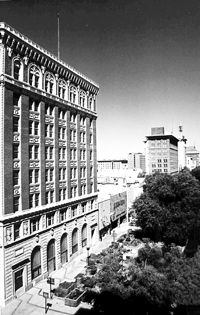| |
|
Keeping with this concept are
the water features containing ceramic sculptures that call
to mind the irrigation standpipes seen in the irrigated
fields and orchards. The color, texture, and pattern of the
Mall's pavement convey a sense of the area's topography. The
ceramic walls with waterfalls, the water winding down a
stream to pools, are reminiscent of the Kings and San Joaquin
Rivers flowing down from the mountains to create the
valley's productivity.
The Fulton Mall is widely regarded as one Eckbo's
masterworks. It is important to know his extensive influence
on 20th Century landscape architecture. He published seven
books and dozens of articles, establishing himself as the
|
 |
| preeminent theorist and reformer in his |
Bank of Italy
looking North |
field.
Fulton Mall is also an exhibit space for one of
the finest public art collection anywhere. In 1964, along with
building the Fulton Mall, Fresno leaders felt the project should be
completed with some major outdoor artworks that everyone could
enjoy. In 1965, donations of $185,000 covered the cost; today it is
valued at several million dollars.
Alongside the major art works, the mosaics on the
bench backs were designed by two local artists, Joyce Aiken and Jean
Ray Laury. Stan Bitters, another local artist, created the ceramic
pipes that soften the angular pools.
This puts Fresno on the
cutting edge of the 20th Century in architecture, art and landscape
design.
HOME |
MAP |
<< BACK
NEXT >> |
|
|



